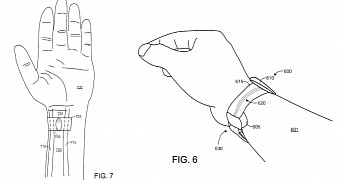Rumor has it that Microsoft abandoned the Band wearable after an experiment to bring Windows 10 IoT on the device failed, and now new information reveled in a patent makes us hope that Redmond would reconsider this idea at some point in the future.
Microsoft has patented a technology developed to be used on its wearables that involves a new heart-rate monitor which could help provide much more than the heart rate.
Specifically, the patent is called “Transducing pressure to a non-invasive pulse sensor” and refers to a new technology called “physical piezo-electric transducer” designed to be installed on smartwatches and fitness trackers (technically, the Microsoft Band is a fitness tracker, but we’re using the word smartwatch to refer to all devices developed to be worn on the wrist).
This new sensor is supposed to be placed between the tendons of your wrist, in the same place used by doctors to actually measure your heart rate, as MSPU notes. This means that the sensor would be able to collect more data (including, but not limited to heart rate variability, arterial blood pressure, pulse-wave velocity, and augmentation index) and also offer increased accuracy as compared to existing solutions which we all know are often imprecise.
How it works
The description section of the patent explains in detail how exactly the new tech is supposed to work and it’s really worth reading if you’re interested in wearables:
“A system for transducing arterial pressure is presented. The system includes a one-piece flexible cap configured to fit around a flexible piezo-resistive sensor that is configured to alter an internal resistance upon deflection.
“The flexible cap includes a deflection wall shaped to conform between a radius and a flexor carpi radialis tendon, and configured to deflect towards the flexible piezo-resistive sensor in proportion to pressure applied by a radial artery. A pressure-transducing medium is sealed between the one-piece flexible cap and the flexible piezo-resistive sensor, such that deflection of the deflection wall towards the flexible piezo-resistive sensor causes proportional deflection of the flexible piezo-resistive sensor.”
Unfortunately, with Microsoft giving up on the Band wearable, it’s hard to believe that the company could actually launch a product boasting such features, but with all Microsoft devices going Surface, there’s still hope that a Surface Watch could see daylight at some point.

 14 DAY TRIAL //
14 DAY TRIAL //